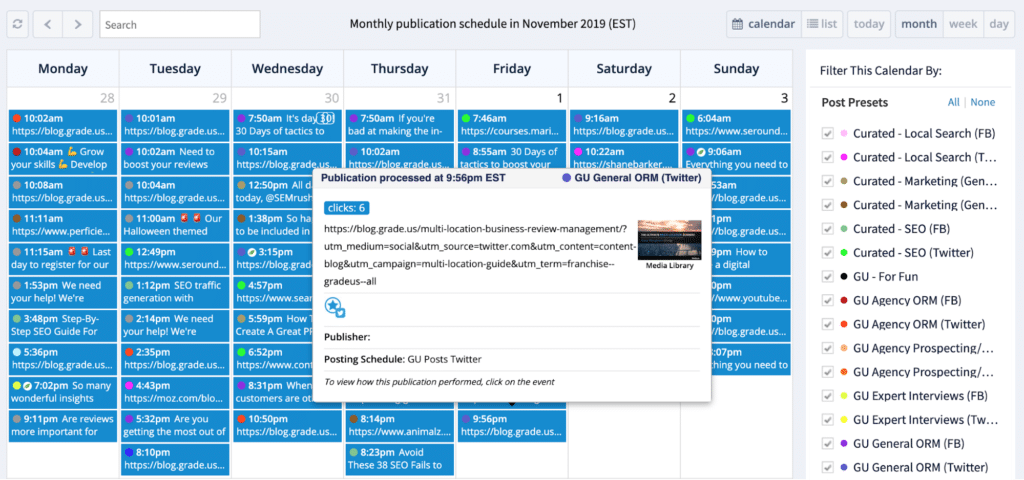It’s been a year for social media.
From Instagram removing ‘likes’ and Facebook data breaches to up-and-comer TikTok battling lawsuits over its ties to China, anyone arguing that these platforms are on the way out would be sorely mistaken.
The stats speak for themselves. Between April 2018 and April 2019 alone, social media users grew by 202 million — averaging out to someone new on social every 6.4 seconds.
Now more than ever, as platforms continue to draw attention and evolve into the new year, it’s important as a business to go in with a digital marketing strategy plan. You can’t get by with haphazard posts and unreasonable expectations.
Like any other aspect of your marketing efforts, finding success on social media — an outcome that’s relative to your specific business — requires thoughtful preparation and time. It’s an investment, one you have to be willing to make in order to justify a presence on these channels in the first place.
As you work to draft out professional and process-based documentation for the new year, set a couple of hours aside to think through how social media will play into the bigger picture.
Here are a handful of items to keep in mind as you start preparing your social media strategy for 2020:
Table of Contents
Start your free 14-day Fanbooster trial
Create attainable objectives for your business
It’s not enough to simply set objectives for your social media strategy.
Relative to each broader initiative set forth, you have to define specific goals.
SMART goal-setting offers a framework for this approach. It provides context to the large idea that is the “strategy”.

When you’re staring into the hypnotizing glow of that blank social media strategy document on your computer screen, treat it as a brainstorming session. Start by typing out anything and everything you would want your business to achieve on social in the year ahead.

The sky’s the limit — just get something down on paper.
With all of your initial ideas in front of you, the next step is to validate them with research.
Specifically:
- If you’ve been active on social in years past, take a look at what’s worked versus what hasn’t based on any previously established KPIs.
- Audit your competitors to get a feel for opportunities you may be missing out on.
Then, use data from past performance and what’s working in your industry to help shape these initial plans into something more tangible.

And more importantly, make sure that what you’re doing on social in the year ahead has ties with every other moving part in the larger marketing machine.
Use a social media posting calendar
If you start your day asking, “What should I post to social?” it’s time for a new approach. More specifically, it’s time to use a calendar to proactively plan content ahead of when you’re posting it.

In theory, you’ll have a broad content calendar to play with for aligning marketing initiatives across channels. For example, if there are upcoming promotional campaigns in the works, a calendar should make note of when it’s happening in addition to where relevant messaging will be distributed (e.g. email, website, social, etc.).
This is also where you can map out opportunities for timely campaigns on social media and other channels.
The National Day Calendar is a useful resource for planning timely campaigns:

Lay out relevant 2020 holidays to your brand — the key word here being relevant. For example, you don’t have to post something for July 4th just because it’s a national holiday. This is especially true if all you’re going to post is a stock photo of fireworks with a caption that reads, “Happy July 4th!”.
If you’ve done this in the past — don’t fret. We’ve all been there.
Similarly, you don’t need to share something for National Ice Cream Day if your company sells tires.
At any rate, your audience wants meaningful content. If you’re creating content that isn’t directly tied back to your audience and specific goals, you’re wasting resources.
Make sure you have the right tools in place
There’s a difference between strategy-based documents and the tools that are actually going to help you execute on them. You may have a calendar built out via an Excel spreadsheet, for example, but you’ll also need something to help you schedule out that content in advance.
To maximize your social media strategy potential in 2020, get the right tools up and running before January rolls around. If you work in a company (versus working for yourself), it’s important to come into the beginning of the year with an idea of the tools you need to do your job well, as this is prime time for deciding on each department’s budget.
Do your research around social media tools that can help you in the following areas:
- Scheduling posts in advance
- Social listening
- Community engagement
- Reporting and analytics
- Social media team management
If you have tools that you’re already using but that you’re less than thrilled with, now is the time to list out those grievances. As channels continue to evolve, it doesn’t hurt to regularly shop around for social media management software and compare features.
Take advantage of free trial offers and see what works best for your team. Bring any negatives about the product to your sales rep to get a feel for possible workarounds and their 2020 product roadmap.
Set a social media marketing budget
Any budget is better than no budget when it comes to your social media strategy for 2020. As many experts in the field will tell you, there are ways to make a little Facebook ad budget go a long way.
As digital audiences grow increasingly more segmented, content channels increase in saturation, and organic reach fades into the background — ads matter. Especially if your end goal is to drive sales, which it undoubtedly is.
If 2020 will be your first time testing out social advertising for your business, keep the budget small. Look at your finances and feel out a number for the year that feels manageable.
You can break that number out into a monthly spend amount on social. This amount can always ebb and flow to accommodate major campaigns throughout the year.
Note that Facebook and Google Local ads will tend to be cheaper than Instagram, Twitter, Snapchat, TikTok, or LinkedIn ads. That said, cheaper ad pricing doesn’t really matter if your audience is on those more expensive platforms. Take the time to understand your audience, then plan your budget accordingly.
Just make sure not to set your ads and forget them. Review and analyze their performance, test different audiences (e.g. lookalikes, interest-based, contact lists, etc.) and ad types. Then, focus ad spend on the channels giving you the most return for your efforts.
Being mindful of time: Creating & executing your digital marketing strategy plan
The last important piece of the digital marketing strategy plan puzzle involves the dimension of time.
Specifically, start brainstorming how much time you need to set aside each week for:
- Commissioning or creating image and video assets
- Commissioning or writing creative and compelling text captions
- Executing organic outreach campaigns to build relationships and grow your audience
- Providing customer service and responding to post replies on social media
Thinking more big picture, how much time is each week’s social media activities going to require based on quantity, research, medium, and creation?
Once you’ve landed on a rough estimate, add time blocks in your calendar to address each task. After you’ve had a few weeks to test out your time estimates, go back in and reconfigure these time blocks based on the real amount of time each task takes, on average.
A failure to plan means that all of this stuff happens at the last minute, meaning that your social media action plan will seem more cobbled together than the result of a smart strategy.
Final Thoughts: How to start preparing your digital marketing strategy plan for 2020
Prepping your digital marketing strategy plan for 2020 is all about taking things piece by piece. From budget to the types of tools you’re using to execute your strategy, there are a number of factors at play in accelerating your social presence.
Remember that whatever you land on can live as a working document, shifting and evolving as the new year unfolds. The idea is to organize those first steps and align your team with reasonable expectations.
With your social media strategy in place, learn how Fanbooster can help with seamless execution.



